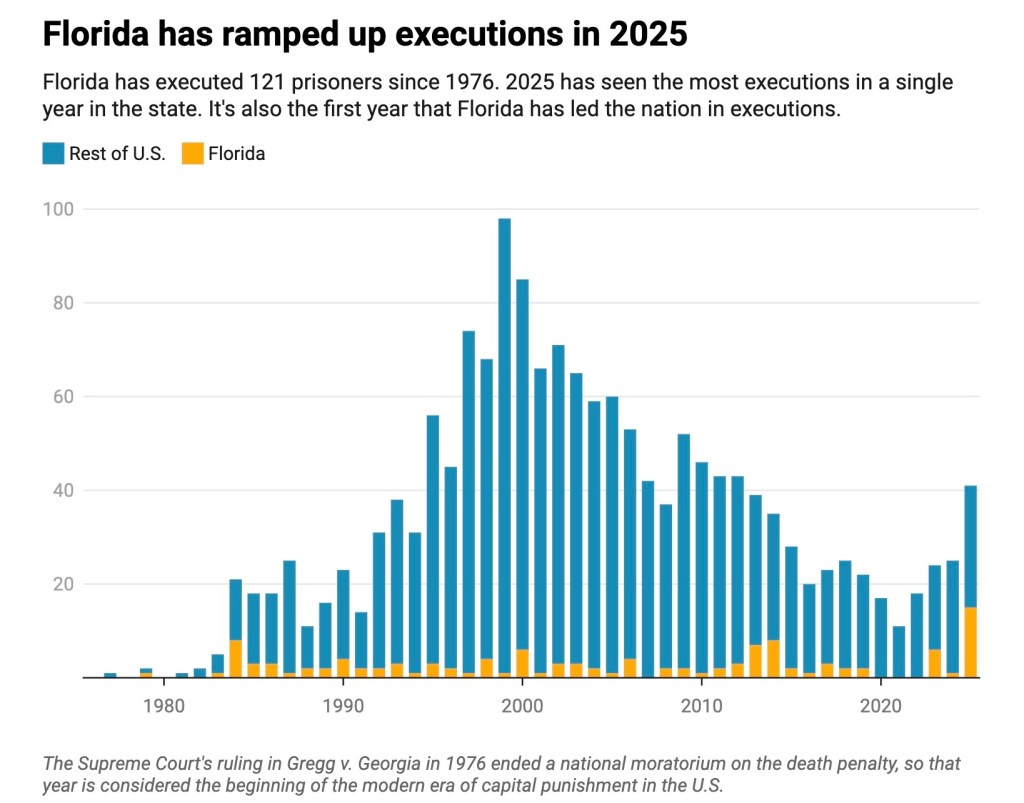
New Times photo-illustration. Ron DeSantis photo by Gage Skidmore/Flickr; scythe etching via Wellcome Collection/Public Domain

Audio By Carbonatix
After years of steady decline in the number of people executed in the United States, there has been a sharp reversal in 2025. So far this year, 41 people have been killed in 11 states, with five more executions scheduled before the end of the year.
If all the scheduled executions are carried out, that would make 2025 the year with the most executions since 2010, when 46 inmates were put to death. That year, Texas led the way with 17 executions, while Florida carried out only one.
But this year, the Sunshine State is leading the charge. Florida has executed 15 prisoners in 2025 — the most ever in a single year since 1976, when a brief national moratorium on the death penalty was lifted. Two of the five remaining executions scheduled for 2025 are set to happen in Florida. Texas and Alabama are tied for a distant second, with five executions each.
As someone who has studied the death penalty for decades, what is happening in Florida right now seems to me to be especially important. While in some ways the state is distinctive, in many others it is a microcosm of America’s death penalty system.
When news happens, Miami New Times is there —
Your support strengthens our coverage.
We’re aiming to raise $30,000 by December 31, so we can continue covering what matters most to you. If Miami New Times matters to you, please take action and contribute today, so when news happens, our reporters can be there.

The History of the Death Penalty in Florida
According to the Death Penalty Information Center, Florida carried out its first execution in 1827, 18 years before it became a state.
Almost 100 years later, in 1923, Florida replaced hanging with the electric chair as its method of execution. After a brief pause in the use of capital punishment in the 1970s, it was one of the first states to get back in the death penalty business.
In the 1990s, the state had several gruesome botched electrocutions. In three cases, the condemned man caught on fire before dying in the chair. To this day, the electric chair remains legal in Florida, though in 2000 the state legislature enacted a law whereby prisoners may choose between the electric chair and lethal injection.
Over the years, the U.S. Supreme Court has taken the state to task for various constitutional defects in its death penalty laws and practices. In its 1982 decision in Enmund v. Florida, the court ruled that Florida could not use the death penalty to punish people who were minor participants in a crime that led to a murder. And in 2014, the Supreme Court found that Florida was unconstitutionally denying the kind of intellectual disability claims by people with low IQ scores that made them ineligible to be given death sentences.
But these rulings have not stopped the state from continuing to go its own way in death penalty cases. In 2020, the Florida Supreme Court ended the practice of having a court review capital sentences. This review was meant to ensure that those sentences met the U.S. Constitution’s requirements that they be meted out only in cases that truly warrant them and that they be proportional. To determine proportionality, the court undertaking such a review would compare the case in front of them with similar cases in the same jurisdiction in which the death penalty had been imposed.
Then in 2023, Florida enacted legislation ending the requirement of jury unanimity in death cases. Now, it takes only eight out of 12 jurors to send someone to death row. Only three other death penalty states do not require jury unanimity. In Missouri and Indiana, a judge may decide if the jury’s decision isn’t unanimous, and in Alabama, a 10-2 decision is sufficient.
Racial Inequality on Death Row
As in the rest of the country, racial discrimination has long been a feature of Florida’s death penalty system.
Thirty-five percent of the 278 people currently on Florida’s death row are Black. But Black people make up only about 17 percent of Florida’s overall population.
This is actually lower than the approximately 40 percent of inmates on death row who are Black nationwide, despite the fact that Black people make up just 14 percent of the U.S. population.
Across the nation, 13 of the 41 inmates executed so far in 2025 have been Black or Latino men. Florida leads the nation in the number of people — 30 — who have been sentenced to death only to be exonerated later. Of those, 57 percent were Black.
A Record-Setting Year
Today, Florida has the second-largest death row population in the United States, with 256 inmates awaiting executions. Only California has more, with 580 inmates on death row, but it has had a moratorium on executions since 2006.
As Florida’s governor, Ron DeSantis is responsible for issuing death warrants. In 2025, he has signed a record-setting 15 so far. That’s the most death warrants in the state in a single year since 2014, when Gov. Rick Scott signed off on putting eight people to death.
Though he is Catholic, DeSantis does not subscribe to the church’s staunch opposition to the death penalty. The Florida Catholic Conference of Bishops has been outspoken in taking him to task for his position on capital punishment and for presiding over an execution spree. But that has not stopped him.
Indeed, on November 3, 2025, the governor said that capital punishment is “an appropriate punishment for the worst offenders.” He added that it could be a “strong deterrent” if the state carried out executions more quickly.
DeSantis has served as governor since 2019, and prior to 2025, he had signed nine death warrants. He says that he was focused on other priorities early in his term and during the COVID-19 pandemic.
The governor, who is term-limited, is in his second and last term. DeSantis’ critics allege that the recent uptick in executions is an attempt to garner attention and prove his tough-on-crime bona fides to a national audience.
Setting the Trend or Bucking It?
The total number of executions in the U.S. went from a high of 98 executions in 1999 to a low of 11 in 2021. But that number has increased every year since.
While only one state, Indiana, has resumed executions after a long hiatus, no other state has increased its use of the death penalty as quickly as Florida has. Elsewhere, the common pattern of allowing people to languish on death row for decades, and in some states seemingly permanently, has held.
And although the problems that have long plagued Florida’s death penalty system remain unaddressed, it now stands alone in dramatically escalating its own pace of executions and is leading America to its own 2025 execution revival.
Editor’s note: New Times occasionally shares articles from The Conversation, a nonprofit collaborative whose team of journalists works with academic experts to produce informative opinion and analysis for a general audience. The views expressed in this commentary are solely those of the writer(s). Unless otherwise noted, the content above was produced solely by The Conversation. This article is republished from The Conversation under a Creative Commons license. Read the original article.